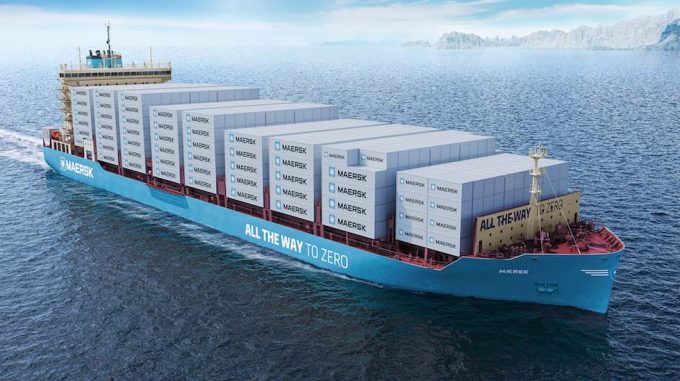NOCC adds third ‘ammonia-ready’ PCTC newbuild orderbook
Norwegian Car Carriers (NOCC) has added a third ‘ammonia-ready’ 7,000ceu LNG-powered ship to its two-vessel, ...
TFII: SOLID AS USUALMAERSK: WEAKENINGF: FALLING OFF A CLIFFAAPL: 'BOTTLENECK IN MAINLAND CHINA'AAPL: CHINA TRENDSDHL: GROWTH CAPEXR: ANOTHER SOLID DELIVERYMFT: HERE COMES THE FALLDSV: LOOK AT SCHENKER PERFORMANCEUPS: A WAVE OF DOWNGRADES DSV: BARGAIN BINKNX: EARNINGS OUTODFL: RISING AND FALLING AND THEN RISING
TFII: SOLID AS USUALMAERSK: WEAKENINGF: FALLING OFF A CLIFFAAPL: 'BOTTLENECK IN MAINLAND CHINA'AAPL: CHINA TRENDSDHL: GROWTH CAPEXR: ANOTHER SOLID DELIVERYMFT: HERE COMES THE FALLDSV: LOOK AT SCHENKER PERFORMANCEUPS: A WAVE OF DOWNGRADES DSV: BARGAIN BINKNX: EARNINGS OUTODFL: RISING AND FALLING AND THEN RISING

Green reports and initiatives reveal the need for leadership during the maritime transition to climate-friendly fuels and operations.
Yesterday the International Maritime Organization released a report by Ricardo and class society DNV on the Future Fuel Technology project, due to be discussed, at July’s environment subcommittee.
The report concludes that 100% decarbonisation is possible by 2050 for the maritime sector, and adds: “The feasibility of these decarbonisation scenarios, and particularly the most ambitious pathways, requires an early clarification of further policy targets and measures to help unlock investment in candidate fuel production and their associated infrastructure.”
Today, a DNV paper points to growing demand for green methanol fuel that will allow vessel fleets to reach net zero emissions, with a growing number of methanol powered containerships now on order. However fuel for these will not be immediately available until the infrastructure for producing green methanol is ramped up.
Currently, says DNV, there are 122 ports with methanol storage facilities, but “green methanol is not available in significant quantities,” according to Christos Chryssakis, its business development manager.
He added: “Many companies are willing to invest in production, but want to see the demand first.”
Thhe IMO agrees and argues that the technical feasibility for commercial development of green fuels, “particularly in the short term”, already exists.
Yesterday HMM announced it would fit a carbon capture and storage system to a containership this year. The CO2 would then be used for other green industrial purposes, said the carrier.
And Finnish company Wärtsilä has successfully de-rated a large engine, cutting down the power output by reducing the size of its cylinders. The company has a further 20 orders for ships with the same engine.
Radically de-rating engines can save up to 15% according to general manager Sangram Nanda. Costs for such complex modifications can be between $4m and $6m, but even a 10% saving on fuel costs, at a consumption of 200 tonnes/day at $500/tonne, would see a repayment period of roughly two years.
Meanwhile, the external pressures on the maritime sector are continuing to ramp up. In the US a local pressure group, Pacific Environment has been successful in persuading city councils, including those in Long Beach, Los Angeles and even landlocked Minneapolis, to pass non-binding resolutions to decarbonise ports by 2030.
Pacific Environment local representative Dawny’all Heydari told The Loadstar: “This is just the first step.”
Tthe group has also been successful in getting the port of Long Beach to remove LNG bunkering from its masterplan and is expecting to develop binding resolutions in the future.
“We need to ban new or expanded fossil fuel bunkering,” said Ms Heydari., adding that this meant investing heavily in zero emission technology, a goal backed by the World Shipping Council.
Its VP for environment & climate, Bryan Wood-Thomas urged IMO member states to adopt global regulations that set clear goals and provide incentives to energy companies to produce truly green fuels.
“That means setting a global price on carbon, focusing on the full fuel lifecycle to ensure real environmental impact, integrated development of global production and supply of near-zero GHG fuels, green corridors programmes and setting newbuild standards to transition the fleet to zero-GHG technologies.”
Listen to Steve McCrindle, DP World’s port operations director at Southampton, explain how the deployment of sustainable fuels at the quayside is now dramatically reducing emissions
Comment on this article